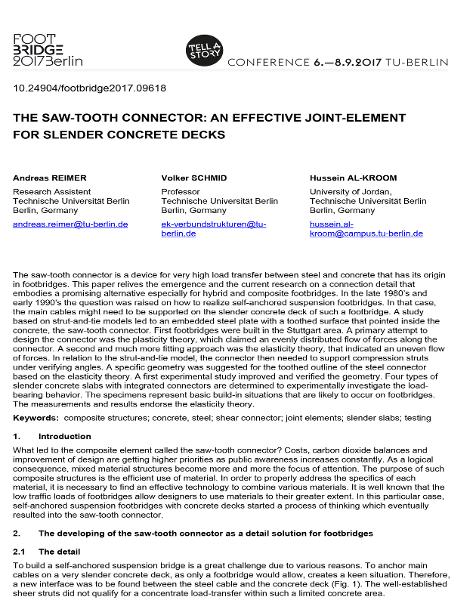The Saw-Tooth Connector: An Effective Joint-Element for Slender Concrete Decks

| Autor(en): |
Andreas Reimer
Volker Schmid Hussein Al-Kroom |
|---|---|
| Medium: | Tagungsbeitrag |
| Sprache(n): | Englisch |
| Tagung: | Footbridge 2017 Berlin - Tell A Story, 6-8.9.2017, Technische Universität Berlin (TU Berlin) |
| Veröffentlicht in: | Footbridge 2017 Berlin - Tell A Story |
| Jahr: | 2017 |
| DOI: | 10.24904/footbridge2017.09618 |
| Abstrakt: |
The saw-tooth connector is a devise for very high load transfer between steel and concrete that has its origin in footbridges. This paper relives the emergence and the current research on a connection detail that embodies a promising alternative especially for hybrid and composite footbridges. In the late 1980's and early 1990's the question was raised on how to realize self-anchored suspension footbridges. In that case, the main cables might need to be supported on the slender concrete deck of such a footbridge. A study based on strut-and-tie models led to an embedded steel plate with a toothed surface that pointed inside the concrete, the saw-tooth connector. First footbridges were built in the Stuttgart area. A primary attempt to design the connector was the plasticity theory, which claimed an evenly distributed flow of forces along the connector. A second and much more fitting approach was the elasticity theory, that indicated an uneven flow of forces. In relation to the strut-and-tie model, the connector then needed to support compression struts under verifying angles. A specific geometry was suggested for the toothed outline of the steel connector based on the elasticity theory. A first experimental study improved and verified the geometry. Four types of slender concrete slabs with integrated connectors are determined to experimentally investigate the loadbearing behavior. The specimens represent basic build-in situations that are likely to occur on footbridges. The measurements and results endorse the elasticity theory. |
| Stichwörter: |
Stahl Beton Verbundkonstruktionen
|
| Lizenz: | Dieses Werk ist urheberrechtlich geschützt. Der/die Urheber erteilt durch die Veröffentlichung nur das Recht, dieses Werk zu betrachten/lesen und herunterzuladen. Eine weitere Vervielfältigung und Veröffentlichung bedarf der Genehmigung des Urhebers/der Urheber. |
0.88 MB Volltext herunterladen (PDF-Datei)
0.81 MB
- Über diese
Datenseite - Reference-ID
10075322 - Veröffentlicht am:
01.09.2017 - Geändert am:
10.06.2021



